Analysis of the Interior Microclimate in Art Nouveau Heritage Buildings for the Protection of Exhibits and Human Health
Abstract
1. Introduction
2. Materials and Methods
- The Exhibition hall–Ground floor of the museum has dimensions of 7.30 m long, 4.90 m wide and 3.85 m high, with a total volume of 137.7 m3. It presents to the interested public authentic pieces of clothing, jewelry and various accessories, mostly intended for women. The construction materials of the exhibits are among the most diverse, imposing: wood, leather, textiles, cellulose, stones and precious materials. Unlike other rooms of the museum, most of the exhibits in this room are kept in glass domes, for better preservation. The room communicates with the outside through a door measuring 1.2 m × 2.5 m and a window measuring 3.2 m × 3.9 m;
- The bedroom on the 1st floor of the museum is impressive with dimensions of 6.30 m long, 4.70 m wide and 3.85 m high, with a total volume of approximately 114 m3. It is one of the most interesting exhibition halls in the museum, mainly including precious furniture. This room differs from the others in that it is closed to public access, viewing only through the 1.5 m wide door. The room has a window with dimensions of 3.2 × 3.2 m;
- The great hall located on the 1st floor is usually divided into two smaller rooms, which communicate with each other through a 2.5 × 2.5 m door, which is permanently open. For this reason, the two rooms were ventilated as a whole, the internal microclimate not registering very big differences. The two rooms have total dimensions of 14.7 m length, 4.9 m width and 3.85 m height, with a volume of approximately 277.3 m3. Within them, you can find especially old furniture and decorations, made of wood or textile materials. They are the rooms where piano concerts, various meetings or workshops take place quite frequently. The two rooms each have a window measuring 4.05 m wide and 2.3 m high (Figure 3).
3. Results
4. Discussion
5. Conclusions
6. Future Work
Author Contributions
Funding
Institutional Review Board Statement
Informed Consent Statement
Data Availability Statement
Acknowledgments
Conflicts of Interest
References
- Günay, B. Museum Concept from Past to Present and Importance of Museums as Centers of Art Education. Procedia-Soc. Behav. Sci. 2012, 55, 1250–1258. [Google Scholar] [CrossRef]
- Vareiro, L.; Barbosa, S.B.; Sousa, S.S. The Importance of Museums in the Tourist Development and the Motivations of Their Visitors: An Analysis of the Costume Museum in Viana Do Castelo. J. Cult. Herit. Manag. Sustain. Dev. 2020, 11, 39–57. [Google Scholar] [CrossRef]
- Deac, L.A.; Gozner, M.; Sambou, A. Ethnographic museums in the rural areas of Crișana region, Romania–keepers of local heritage, tradition and lifestyle. Geoj. Tour. Geosites 2019, 27, 1251–1260. [Google Scholar] [CrossRef]
- Ilies, D.C.; Caciora, T.; Herman, G.V.; Ilies, A.; Ropa, M.; Baias, S. Geohazards affecting cultural heritage monuments. A complex case study from Romania. GeoJ. Tour. Geosites 2020, 31, 1103–1112. [Google Scholar] [CrossRef]
- Uring, P.; Chabas, A.; Alfaro, S.; Derbez, M. Assessment of Indoor Air Quality for a Better Preventive Conservation of Some French Museums and Monuments. Environ. Sci. Pollut. Res. Int. 2020, 27, 42850–42867. [Google Scholar] [CrossRef]
- Uring, P.; Chabas, A.; Alfaro, S. Dust Deposition on Textile and Its Evolution in Indoor Cultural Heritage. Eur. Phys. J. Plus 2019, 134, 255. [Google Scholar] [CrossRef]
- Ilieș, D.C.; Marcu, F.; Caciora, T.; Indrie, L.; Ilieș, A.; Albu, A.; Costea, M.; Burtă, L.; Baias, Ș.; Ilieș, M.; et al. Investigations of Museum Indoor Microclimate and Air Quality. Case Study from Romania. Atmosphere 2021, 12, 286. [Google Scholar] [CrossRef]
- Askari, H.; Altan, H. Museum Indoor Environments and Their Effect on Human Health, Comfort, Performance and Productivity. In Proceedings of the SEEP 2014 Conference, Dubai, United Arab Emirates, 23 November 2014. [Google Scholar]
- Silva, H.E.; Henriques, F.M.A. Microclimatic Analysis of Historic Buildings: A New Methodology for Temperate Climates. Build. Environ. 2014, 82, 381–387. [Google Scholar] [CrossRef]
- Mısırlısoy, D.; Günçe, K. Adaptive Reuse Strategies for Heritage Buildings: A Holistic Approach. Sustain. Cities Soc. 2016, 26, 91–98. [Google Scholar] [CrossRef]
- Litti, G.; Audenaert, A.; Fabbri, K. Indoor Microclimate Quality (IMQ) Certification in Heritage and Museum Buildings: The Case Study of Vleeshuis Museum in Antwerp. Build. Environ. 2017, 124, 478–491. [Google Scholar] [CrossRef]
- Varas-Muriel, M.J.; Fort, R. Microclimatic Monitoring in an Historic Church Fitted with Modern Heating: Implications for the Preventive Conservation of Its Cultural Heritage. Build. Environ. 2018, 145, 290–307. [Google Scholar] [CrossRef]
- Aste, N.; Adhikari, R.S.; Buzzetti, M.; Della Torre, S.; Del Pero, C.; Huerto, C.H.E.; Leonforte, F. Microclimatic Monitoring of the Duomo (Milan Cathedral): Risks-Based Analysis for the Conservation of Its Cultural Heritage. Build. Environ. 2019, 148, 240–257. [Google Scholar] [CrossRef]
- Bucur, E.; Danet, A.F.; Lehr, C.B.; Lehr, E.; Nita-Lazar, M. Binary Logistic regression—Instrument for Assessing Museum Indoor Air Impact on Exhibits. J. Air Waste Manag. Assoc. 2017, 67, 391–401. [Google Scholar] [CrossRef] [PubMed]
- Fabbri, K.; Bonora, A. Two New Indices for Preventive Conservation of the Cultural Heritage: Predicted Risk of Damage and Heritage Microclimate Risk. J. Cult. Herit. 2021, 47, 208–217. [Google Scholar] [CrossRef]
- Balocco, C.; Petrone, G.; Maggi, O.; Pasquariello, G.; Albertini, R.; Pasquarella, C. Indoor Microclimatic Study for Cultural Heritage Protection and Preventive Conservation in the Palatina Library. J. Cult. Herit. 2016, 22, 956–967. [Google Scholar] [CrossRef]
- Ilies, D.C.; Onet, A.; Herman, G.V.; Indrie, L.; Ilies, A.; Burta, L.; Gaceu, O.; Marcu, F.; Baias, S.; Caciora, T.; et al. Exploring the indoor environment of heritage buildings and its role in the conservation of valuable objects. Environ. Eng. Manag. J. 2019, 18, 2579–2586. [Google Scholar] [CrossRef]
- Marcu, F.; Hodor, N.; Indrie, L.; Dejeu, P.; Ilieș, M.; Albu, A.; Sandor, M.; Sicora, C.; Costea, M.; Ilieș, D.C.; et al. Microbiological, Health and Comfort Aspects of Indoor Air Quality in a Romanian Historical Wooden Church. Int. J. Environ. Res. Public Health 2021, 18, 9908. [Google Scholar] [CrossRef]
- Onet, A.; Ilies, D.C.; Ilies, A.; Herman, G.V.; Burta, L.; Marcu, F.; Buhas, R.; Caciora, T.; Baias, S.; Onet, C.; et al. Indoor air quality assessment and its perception. Case study historic wooden church, Romania. Rom. Biotechnol. Lett. 2020, 25, 1547–1553. [Google Scholar] [CrossRef]
- Ilies, D.C.; Onet, A.; Marcu, F.M.; Gaceu, O.R.; Timar, A.; Baias, S.; Ilies, A.; Herman, G.V.; Costea, M.; Tepelea, M.; et al. Investigations on air quality in the historic wooden church in Oradea City, Romania. Environ. Eng. Manag. J. 2018, 17, 2731–2739. [Google Scholar] [CrossRef]
- Chianese, E.; Riccio, A.; Duro, I.; Trifuoggi, M.; Iovino, P.; Capasso, S.; Barone, G. Measurements for Indoor Air Quality Assessment at the Capodimonte Museum in Naples (Italy). Int. J. Environ. Res. 2021, 6, 509–518. [Google Scholar]
- Sofia, D.; Gioiella, F.; Lotrecchiano, N.; Giuliano, A. Mitigation strategies for reducing air pollution. Environ. Sci. Pollut. Res. Int. 2020, 27, 19226–19235. [Google Scholar] [CrossRef] [PubMed]
- Lotrecchianoa, N.; Sofiaa, D.; Giulianoa, A.; Barlettaa, D.; Polettoa, M. Real-time on-road monitoring network of air quality. Chem. Eng. Trans. 2019, 74, 241–246. [Google Scholar]
- US Environmental Protection Agency. Program Needs for Indoor Environments Research (PNIER). 2005. Available online: https://www.epa.gov/sites/default/files/2014-08/documents/pnier.pdf (accessed on 29 October 2022).
- World Health Organization. Global Health Risks. Mortality and Burden of Disease Attributable to Selected Major Risks. 2009. Available online: https://www.who.int/publications/i/item/9789241563871 (accessed on 29 October 2022).
- Cincinelli, A.; Martellini, T.; Amore, A.; Dei, L.; Marrazza, G.; Carretti, E.; Belosi, F.; Ravegnani, F.; Leva, P. Measurement of Volatile Organic Compounds (VOCs) in Libraries and Archives in Florence (Italy). Sci. Total Environ. 2016, 572, 333–339. [Google Scholar] [CrossRef] [PubMed]
- González-Martín, J.; Kraakman, N.J.R.; Pérez, C.; Lebrero, R.; Muñoz, R. A State-of-the-Art Review on Indoor Air Pollution and Strategies for Indoor Air Pollution Control. Chemosphere 2021, 262, 128376. [Google Scholar] [CrossRef]
- Zorpas, A.A.; Skouroupatis, A. Indoor air quality evaluation of two museums in a subtropical climate conditions. Sustain. Cities Soc. 2016, 20, 52–60. [Google Scholar] [CrossRef]
- Dzulkifli, S.N.M.; Abdullah, A.H.; Leman, A.M. Indoor Air Quality of Museum Building Environment in a Tropical Climate: Proposed Study. In Proceedings of the 3rd Scientific Conference on Occupational Safety and Health, Johor Bahru, Malaysia, 14–17 October 2014. [Google Scholar]
- Azuma, K.; Ikeda, K.; Kagi, N.; Yanagi, U.; Osawa, H. Physicochemical Risk Factors for Building-Related Symptoms in Air-Conditioned Office Buildings: Ambient Particles and Combined Exposure to Indoor Air Pollutants. Sci. Total Environ. 2018, 616–617, 1649–1655. [Google Scholar] [CrossRef]
- Baldan, M.; Manente, S.; Izzo, F.C. The Role of Bio-Pollutants in the Indoor Air Quality of Old Museum Buildings: Artworks Biodeterioration as Preview of Human Diseases. Environ. Monit. Assess. 2021, 193, 787. [Google Scholar] [CrossRef]
- Hosseini, M.R.; Fouladi-Fard, R.; Aali, R. COVID-19 Pandemic and Sick Building Syndrome. Indoor Built Environ. 2020, 29, 1181–1183. [Google Scholar] [CrossRef]
- Fard, R.F.; Hosseini, M.R.; Faraji, M.; Oskouei, A.O. Building Characteristics and Sick Building Syndrome among Primary School Students. Sri Lanka J. Child Health 2018, 47, 332. [Google Scholar] [CrossRef]
- Lloyd, H.; Lithgow, K.; Brimblecombe, P.; Yoon, Y.H.; Frame, K.; Knight, B. The Effects of Visitor Activity on Dust in Historic Collections. Conservator 2002, 26, 72–84. [Google Scholar] [CrossRef]
- Mašková, L.; Smolik, J.; Travnickova, T.; Havlica, J.; Ondráčková, L.; Ondráček, J. Contribution of Visitors to the Indoor PM in the National Library in Prague, Czech Republic. Aerosol Air Qual. Res. 2016, 16, 1713–1721. [Google Scholar] [CrossRef]
- Grau-Bové, J.; Mazzei, L.; Thickett, D.; Vlachou-Mogire, C.; Strlic, M. Diagrams of Equal Area Coverage: A New Method to Assess Dust Deposition in Indoor Heritage Environments. In Proceedings of the ICOM-CC 18th Triennial Conference Preprints, Copenhagen, Denmark, 4–8 September 2017; Bridgland, J., Ed.; International Council of Museums (ICOM): Paris, France, 2017; Volume 18. [Google Scholar]
- Schieweck, A.; Salthammer, T. Indoor air quality in passive-type museum showcases. J. Cult. Herit. 2011, 12, 205–213. [Google Scholar] [CrossRef]
- Tsantaki, E.; Smyrnakis, E.; Constantinidis, T.C.; Benos, A. Indoor Air Quality and Sick Building Syndrome in a University Setting: A Case Study in Greece. Int. J. Environ. Health Res. 2022, 32, 595–615. [Google Scholar] [CrossRef] [PubMed]
- Georgescu, M.S.; Ochinciuc, C.V.; Georgescu, E.; Colda, I. Heritage and Climate Changes in Romania: The St. Nicholas Church of Densus, from Degradation to Restoration. Energy Procedia 2017, 133, 76–85. [Google Scholar] [CrossRef]
- Ferdyn-Grygierek, J. Monitoring of Indoor Air Parameters in Large Museum Exhibition Halls with and without Air-Conditioning Systems. Build. Environ. 2016, 107, 113–126. [Google Scholar] [CrossRef]
- Abdul-Wahab, S.A.; Salem, N.; Ali, S. Evaluation of Indoor Air Quality in a Museum (Bait Al Zubair) and Residential Homes. Indoor Built Environ. 2015, 24, 244–255. [Google Scholar] [CrossRef]
- Reddy, M.K.; Suneela, M.; Sumathi, M.; Reddy, R.C. Indoor Air Quality at Salarjung Museum, Hyderabad, India. Environ. Monit. Assess. 2005, 105, 359–367. [Google Scholar] [CrossRef]
- Nakayama, Y.; Nakaoka, H.; Suzuki, N.; Tsumura, K.; Hanazato, M.; Todaka, E.; Mori, C. Prevalence and Risk Factors of Pre-Sick Building Syndrome: Characteristics of Indoor Environmental and Individual Factors. Environ. Health Prev. Med. 2019, 24, 77. [Google Scholar] [CrossRef]
- Becker, M.; Meyer, F.; Jeong, M.-J.; Ahn, K.; Henniges, U.; Potthast, A. The Museum in a Test Tube—Adding a Third Dimension to the Evaluation of the Impact of Volatile Organic Acids on Paper. Polym. Degrad. Stab. 2016, 130, 109–117. [Google Scholar] [CrossRef]
- Godoi, R.H.M.; Potgieter-Vermaak, S.; Godoi, A.F.L.; Stranger, M.; Van Grieken, R. Assessment of Aerosol Particles within the Rubens’ House Museum in Antwerp, Belgium. X-ray Spectrom. 2008, 37, 298–303. [Google Scholar] [CrossRef]
- Ilse, K.K.; Figgis, B.W.; Naumann, V.; Hagendorf, C.; Bagdahn, J. Fundamentals of Soiling Processes on Photovoltaic Modules. Renew. Sustain. Energy Rev. 2018, 98, 239–254. [Google Scholar] [CrossRef]
- Tétreault, J. Airborne Pollutants in Museums, Galleries and Archives: Risk Assessment, Control Strategies and Preservation Management; Canadian Conservation Institute: Ottawa, ON, Canada, 2003. [Google Scholar]
- El-Mekawy, A.; Awad, A.-H.; Shakour, A.; Saleh, I.; Ibrahium, Y.; Abdellatif, N.; Hassan, S. Effect of Air Pollution on the Deterioration of El Manial Palace and Museum for Greater Conservation of Egyptian Cultural Heritage. Egypt. J. Chem. 2020, 64, 413–423. [Google Scholar] [CrossRef]
- Niklasson, A.; Langer, S.; Arrhenius, K.; Rosell, L.; Bergsten, C.J.; Johansson, L.-G.; Svensson, J.-E. Air Pollutant Concentrations and Atmospheric Corrosion of Organ Pipes in European Church Environments. Stud. Conserv. 2008, 53, 24–40. [Google Scholar]
- Canosa, E.; Norrehed, S. Strategies for Pollutant Monitoring in Museum Environments. 2019. Available online: https://www.diva-portal.org/smash/get/diva2:1324224/FULLTEXT01.pdf (accessed on 5 November 2022).
- Bégin, P.; Deschâtelets, S.; Grattan, D.; Gurnagul, N.; Iraci, J.; Kaminska, E.; Woods, D.; Zou, X. The Effect of Air Pollutants on Paper Stability. Restaurator 1999, 20, 1–21. [Google Scholar] [CrossRef]
- Cavicchioli, A.; de Souza, R.O.C.; Reis, G.R.; Fornaro, A. Indoor Ozone and Nitrogen Dioxide Concentration in Two Museums of the São Paulo Megacity- Brazil. E-Preserv. Sci. 2013, 10, 114–122. [Google Scholar]
- Fabbri, B. Science and Conservation for Museum Collection; Nardini Editore: Tuscany, Italy, 2017; pp. 1–470. [Google Scholar]
- Lavédrine, B.; Lavédrine, J.; Associate Professor Conservation Program Bertrand Lavédrine; Gandolfo, J.-P.; Monod, S.; Lavédrine, P. A Guide to the Preventive Conservation of Photograph Collections; Getty Publications: Los Angeles, CA, USA, 2003. [Google Scholar]
- Smith, G.D.; Derbyshire, A.; Clark, R.J.H. In Situ Spectroscopic Detection of Lead Sulphide on a Blackened Manuscript Illumination by Raman Microscopy. Stud. Conserv. 2002, 47, 250–256. [Google Scholar]
- Paşca, M. Arhitecţii József şi Lászlo Vágó la Oradea; Arca: New York, NY, USA, 2010; pp. 24–32. [Google Scholar]
- Novicov, R. Oradea—The Geometric Art Nouveau’s Ultimate Outpost. Available online: http://www.coupdefouet.cat/admin_ponencies/functions/upload/uploads/Novicov_Ramona_Paper.pdf (accessed on 5 November 2022).
- Grama, V.; Ilies, G.; Safarov, B.; Ilies, A.; Caciora, T.; Hodor, N.; Ilies, D.C.; Kieti, D.; Berdenov, Z.; Josan, I.; et al. Digital Technologies Role in the Preservation of Jewish Cultural Heritage: Case Study Heyman House, Oradea, Romania. Buildings 2022, 12, 1617. [Google Scholar] [CrossRef]
- Sharp, T.R. (Ed.) Chapter 23: Museums, Galleries, Archives and Libraries. In ASHRAE Handbook–HVAC Applications; ASHRAE Research: Atalanta, GA, USA, 2011; pp. 1–23. [Google Scholar]
- ANSI/ASHRAE Standard 62.1-2010; Ventilation for Acceptable Indoor Air Quality. American Society of Heating, Refrigerating and Air-Conditioning Engineers: Atlanta, GA, USA, 2010. Available online: https://www.ashrae.org/file%20library/doclib/public/200418145036_347.pdf (accessed on 28 December 2020).
- Satish, U.; Mendell, M.J.; Shekhar, K.; Hotchi, T.; Sullivan, D.; Streufert, S.; Fisk, W. Is CO2 an Indoor Pollutant? Direct Effects of Low-to-Moderate CO2 Concentrations on Human Decision-Making Performance. Environ. Health Perspect. 2012, 120, 1671–1677. [Google Scholar] [CrossRef]
- Hurlbert, A.; Cuttle, C. New Museum Lighting for People and Paintings. LEUKOS 2020, 16, 1–5. [Google Scholar] [CrossRef]
- Commission Internationale de L’Eclairage. Control of Damage to Museum Objects by Optical Radiation; Commission Internationale de L’Eclairage: Wien, Austria, 2004. [Google Scholar]
- De Graaf, T.; Dessouky, M.; Müller, H.F.O. Sustainable lighting of museum buildings. Renew. Energy 2014, 67, 30–34. [Google Scholar] [CrossRef]
- Lucchi, E. Environmental Risk Management for Museums in Historic Buildings through an Innovative Approach: A Case Study of the Pinacoteca Di Brera in Milan (Italy). Sustain. Sci. Pract. Policy 2020, 12, 5155. [Google Scholar] [CrossRef]
- British Standards Institution. Light and Lighting e Lighting of Work Places e Part 1: Indoor Work Places; English Version EN 12464-1; British Standards Institution: Brussels, Belgium, 2011. [Google Scholar]
- EPA Standard. The National Ambient Air Quality Standards for Particulate Matter-Epa Retains Air Quality Standards for Particle Pollution (Particulate Matter): Fact Sheet. 2020. Available online: https://www.epa.gov/sites/production/files/2020-04/documents/fact_sheet_pm_naaqs_proposal.pdf (accessed on 28 December 2020).
- Hinds, W.C. Aerosol Technology: Properties, Behavior, and Measurement of Airborne Particles; JohnWiley & Sons: Hoboken, NJ, USA, 1999. [Google Scholar]
- Estokova, A.; Stevulov, N. Investigation of Suspended and Settled Particulate Matter in Indoor Air. In Atmospheric Aerosols-Regional Characteristics–Chemistry and Physics; Abdul-Razzak, H., Ed.; IntechOpen: Rijeka, Croatia, 2012; Chapter 18; pp. 455–480. [Google Scholar]
- Sánchez, B.; de Oliveira Souza, M.; Vilanova, O.; Canela, M.C. Volatile organic compounds in the Spanish National Archaeological Museum: Four years of chemometric analysis. Build. Environ. 2020, 174, 106780. [Google Scholar] [CrossRef]
- Air Quality Guidelines for Europe, 2nd ed.; World Health Organization—WHO: Copenhagen, Denmark, 2000.
- EPA Standard, Health Effects Notebook for Hazardous Air Pollutants, Formaldehyde–CAS 50-00-0. Available online: https://www.epa.gov/sites/production/files/2016-09/documents/formaldehyde.pdf (accessed on 28 December 2020).
- Centers for Disease Control and Prevention. What You Should Know about Formaldehyde. Available online: https://www.cdc.gov/nceh/drywall/docs/whatyoushouldknowaboutformaldehyde.pdf (accessed on 28 December 2020).
- Zhang, X.; Wang, Z.; Li, X.; Xu, Z. Variations of HCHO and BTX, Human Health Risk and Indoor Renovation Characteristics of Newly Renovated Rental Apartments in Beijing, China. Indoor Built Environ. 2022, 31, 203–218. [Google Scholar] [CrossRef]
- Environmental Indoor Air Quality Testing & Consulting. Indoor Air Quality (IAQ) Testing in Dallas Austin Houston. 2021. Available online: https://emfsurvey.com/dallas-green-iaq-clearance-testing-post-construction-804-2-certificate-of-occupancy/ (accessed on 28 December 2020).
- Rom, W.N.; Markowitz, S.B. Environmental and Occupational Medicine; Lippincott Williams & Wilkins: Philadelphia, PA, USA, 2007. [Google Scholar]
- World Health Organization. Regional Office for Europe. In Air Quality Guidelines for Europe; WHO Regional Office Europe: Copenhagen, Denmark, 2000. [Google Scholar]
- Department of Health. Advisory Group on the Medical Aspects of Air Pollution Episodes; Second Report: Sulphur dioxide, acid aerosols and particulates; H.M. Stationery Office: London, UK, 1992.
- Bethel, R.A.; Erle, D.J.; Epstein, J.; Sheppard, D.; Nadel, J.A.; Boushey, H.A. Effect of Exercise Rate and Route of Inhalation on Sulfur-Dioxide-Induced Bronchoconstriction in Asthmatic Subjects. Am. Rev. Respir. Dis. 1983, 128, 592–596. [Google Scholar] [PubMed]
- Lawther, P.J.; Macfarlane, A.J.; Waller, R.E.; Brooks, A.G. Pulmonary Function and Sulphur Dioxide, Some Preliminary Findings. Environ. Res. 1975, 10, 355–367. [Google Scholar] [CrossRef]
- Horstman, D.H.; Seal, E., Jr.; Folinsbee, L.J.; Ives, P.; Roger, L.J. The Relationship between Exposure Duration and Sulfur Dioxide-Induced Bronchoconstriction in Asthmatic Subjects. Am. Ind. Hyg. Assoc. J. 1988, 49, 38–47. [Google Scholar] [CrossRef]
- Horstman, D.H.; Folinsbee, L.J.; Ives, P.J.; Abdul-Salaam, S.; McDonnell, W.F. Ozone Concentration and Pulmonary Response Relationships for 6.6-Hour Exposures with Five Hours of Moderate Exercise to 0.08, 0.10, and 0.12 Ppm. Am. Rev. Respir. Dis. 1990, 142, 1158–1163. [Google Scholar] [CrossRef]
- Ras, M.R.; Borrull, F.; Marcé, R.M. Sampling and Preconcentration Techniques for Determination of Volatile Organic Compounds in Air Samples. Trends Analyt. Chem. 2009, 28, 347–361. [Google Scholar] [CrossRef]
- Latza, U.; Gerdes, S.; Baur, X. Effects of Nitrogen Dioxide on Human Health: Systematic Review of Experimental and Epidemiological Studies Conducted between 2002 and 2006. Int. J. Hyg. Environ. Health 2009, 212, 271–287. [Google Scholar] [CrossRef]
- Barnett, A.G.; Williams, G.M.; Schwartz, J.; Best, T.L.; Neller, A.H.; Petroeschevsky, A.L.; Simpson, R.W. The Effects of Air Pollution on Hospitalizations for Cardiovascular Disease in Elderly People in Australian and New Zealand Cities. Environ. Health Perspect. 2006, 114, 1018–1023. [Google Scholar] [CrossRef]
- Mann, J.K.; Tager, I.B.; Lurmann, F.; Segal, M.; Quesenberry, C.P., Jr.; Lugg, M.M.; Shan, J.; Van Den Eeden, S.K. Air Pollution and Hospital Admissions for Ischemic Heart Disease in Persons with Congestive Heart Failure or Arrhythmia. Environ. Health Perspect. 2002, 110, 1247–1252. [Google Scholar] [CrossRef] [PubMed]
- Tsai, S.-S.; Goggins, W.B.; Chiu, H.-F.; Yang, C.-Y. Evidence for an Association between Air Pollution and Daily Stroke Admissions in Kaohsiung, Taiwan. Stroke 2003, 34, 2612–2616. [Google Scholar] [CrossRef] [PubMed]
- Tsai, S.-S.; Huang, C.-H.; Goggins, W.B.; Wu, T.-N.; Yang, C.-Y. Relationship between Air Pollution and Daily Mortality in a Tropical City: Kaohsiung, Taiwan. J. Toxicol. Environ. Health A 2003, 66, 1341–1349. [Google Scholar] [CrossRef] [PubMed]
- Hinwood, A.L.; De Klerk, N.; Rodriguez, C.; Jacoby, P.; Runnion, T.; Rye, P.; Landau, L.; Murray, F.; Feldwick, M.; Spickett, J. The Relationship between Changes in Daily Air Pollution and Hospitalizations in Perth, Australia 1992–1998: A Case-Crossover Study. Int. J. Environ. Health Res. 2006, 16, 27–46. [Google Scholar] [CrossRef]
- Lin, M.; Chen, Y.; Burnett, R.T.; Villeneuve, P.J.; Krewski, D. Effect of Short-Term Exposure to Gaseous Pollution on Asthma Hospitalisation in Children: A Bi-Directional Case-Crossover Analysis. J. Epidemiol. Community Health 2003, 57, 50–55. [Google Scholar] [CrossRef] [PubMed][Green Version]
- Migliaretti, G.; Cavallo, F. Urban Air Pollution and Asthma in Children. Pediatr. Pulmonol. 2004, 38, 198–203. [Google Scholar] [CrossRef]
- Migliaretti, G.; Cadum, E.; Migliore, E.; Cavallo, F. Traffic Air Pollution and Hospital Admission for Asthma: A Case-Control Approach in a Turin (Italy) Population. Int. Arch. Occup. Environ. Health 2005, 78, 164–169. [Google Scholar] [CrossRef]
- Kangas, J.; Jäppinen, P.; Savolainen, H. Exposure to Hydrogen Sulfide, Mercaptans and Sulfur Dioxide in Pulp Industry. Am. Ind. Hyg. Assoc. J. 1984, 45, 787–790. [Google Scholar] [CrossRef]
- Lee, J.A.; Thorne, P.S.; Reynolds, S.J.; O’Shaughnessy, P.T. Monitoring Risks in Association with Exposure Levels among Wastewater Treatment Plant Workers. J. Occup. Environ. Med. 2007, 49, 1235–1248. [Google Scholar] [CrossRef]
- Al-Batanony, M.A.; El-Shafie, M.K. Work-Related Health Effects among Wastewater Treatment Plants Workers. Int. J. Occup. Environ. Med. 2011, 2, 237–244. [Google Scholar]
- Farahat, S.A.; Kishk, N.A. Cognitive Functions Changes among Egyptian Sewage Network Workers. Toxicol. Ind. Health 2010, 26, 229–238. [Google Scholar] [CrossRef] [PubMed]
- Lewis, R.J.; Copley, G.B. Chronic Low-Level Hydrogen Sulfide Exposure and Potential Effects on Human Health: A Review of the Epidemiological Evidence. Crit. Rev. Toxicol. 2015, 45, 93–123. [Google Scholar] [CrossRef] [PubMed]
- Air Quality Criteria for Carbon Monoxide. Washington, DC, US Environmental Protection Agency. 2000. Available online: https://cfpub.epa.gov/si/si_public_record_report.cfm?Lab=NCEA&dirEntryId=18163 (accessed on 28 December 2020).
- Abelsohn, A.; Sanborn, M.D.; Jessiman, B.J.; Weir, E. Identifying and Managing Adverse Environmental Health Effects: 6. Carbon Monoxide Poisoning. Can. Med. Assoc. J. 2002, 166, 1685–1690. [Google Scholar]
- Benignus, V.A.; Muller, K.E.; Barton, C.N.; Prah, J.D. Effect of Low Level Carbon Monoxide on Compensatory Tracking and Event Monitoring. Neurotoxicol. Teratol. 1987, 9, 227–234. [Google Scholar] [CrossRef] [PubMed]
- Samoli, E.; Touloumi, G.; Schwartz, J.; Anderson, H.R.; Schindler, C.; Forsberg, B.; Vigotti, M.A.; Vonk, J.; Kosnik, M.; Skorkovsky, J.; et al. Short-Term Effects of Carbon Monoxide on Mortality: An Analysis within the APHEA Project. Environ. Health Perspect. 2007, 115, 1578–1583. [Google Scholar] [CrossRef] [PubMed]
- Koehler, R.C.; Traystman, R.J. Cerebrovascular Effects of Carbon Monoxide. Antioxid. Redox Signal. 2002, 4, 279–290. [Google Scholar] [CrossRef] [PubMed]
- Kalay, N.; Ozdogru, I.; Cetinkaya, Y.; Eryol, N.K.; Dogan, A.; Gul, I.; Inanc, T.; Ikizceli, I.; Oguzhan, A.; Abaci, A. Cardiovascular Effects of Carbon Monoxide Poisoning. Am. J. Cardiol. 2007, 99, 322–324. [Google Scholar] [CrossRef]
- Public Health England. Methane. General Information. 2019. Available online: https://assets.publishing.service.gov.uk/government/uploads/system/uploads/attachment_data/file/769766/Methane_PHE_general_information__070119.pdf (accessed on 28 December 2020).
- Public Health England. Methane. Incident Management. 2019. Available online: https://assets.publishing.service.gov.uk/government/uploads/system/uploads/attachment_data/file/567592/methane_incident_management.pdf (accessed on 28 December 2020).
- Rossi, E.; Pecorini, I.; Iannelli, R. Methane Oxidation of Residual Landfill Gas in a Full-Scale Biofilter: Human Health Risk Assessment of Volatile and Malodours Compound Emissions. Environ. Sci. Pollut. Res. Int. 2021, 28, 24419–24431. [Google Scholar] [CrossRef]
- Prasad, S.; Zhao, L.; Gomes, J. Methane and Natural Gas Exposure Limits. Epidemiology 2011, 22, S251. [Google Scholar] [CrossRef]
- Semple, S.; Apsley, A.; Wushishi, A.; Smith, J. Commentary: Switching to Biogas—What Effect Could It Have on Indoor Air Quality and Human Health? Biomass Bioenergy 2014, 70, 125–129. [Google Scholar] [CrossRef]
- Zhang, Y.; Wang, S.; Fan, X.; Ye, X. Temperature Modulation of the Health Effects of Particulate Matter in Beijing, China. Environ. Sci. Pollut. Res. Int. 2018, 25, 10857–10866. [Google Scholar] [CrossRef] [PubMed]
- Wang, M.-Z.; Zheng, S.; He, S.-L.; Li, B.; Teng, H.-J.; Wang, S.-G.; Yin, L.; Shang, K.-Z.; Li, T.-S. The Association between Diurnal Temperature Range and Emergency Room Admissions for Cardiovascular, Respiratory, Digestive and Genitourinary Disease among the Elderly: A Time Series Study. Sci. Total Environ. 2013, 456–457, 370–375. [Google Scholar] [CrossRef] [PubMed]
- Gysels, K.; Deutsch, F.; Van Grieken, R. Characterisation of Particulate Matter in the Royal Museum of Fine Arts, Antwerp, Belgium. Atmos. Environ. 2002, 36, 4103–4113. [Google Scholar] [CrossRef]
- Hu, T.; Jia, W.; Cao, J.; Huang, R.; Li, H.; Liu, S.; Ma, T.; Zhu, Y. Indoor Air Quality at Five Site Museums of Yangtze River Civilization. Atmos. Environ. 2015, 123, 449–454. [Google Scholar] [CrossRef]
- USEPA. Fundamentals of Indoor Air Quality in Buildings. Available online: https://www.epa.gov/sites/default/files/2014-08/documents/occupants_guide.pdf (accessed on 31 October 2022).
- Kristak, L.; Antov, P.; Bekhta, P.; Lubis, M.A.R.; Iswanto, A.H.; Reh, R.; Sedliacik, J.; Savov, V.; Taghiyari, H.R.; Papadopoulos, A.N.; et al. Recent Progress in Ultra-Low Formaldehyde Emitting Adhesive Systems and Formaldehyde Scavengers in Wood-Based Panels: A Review. Wood Mat. Sci. Eng. 2022, 17, 1–20. [Google Scholar] [CrossRef]
- Van Tran, V.; Park, D.; Lee, Y.-C. Indoor Air Pollution, Related Human Diseases, and Recent Trends in the Control and Improvement of Indoor Air Quality. Int. J. Environ. Res. Public Health 2020, 17, 2927. [Google Scholar] [CrossRef]
- Fang, L.; Clausen, G.; Fanger, P.O. Impact of Temperature and Humidity on the Perception of Indoor Air Quality. Indoor Air 1998, 8, 80–90. [Google Scholar] [CrossRef]
- Licht, F.G. Good Lighting for Museums, Galleries and Exhibitions 18. Art Book 2002, 9, 13–18. [Google Scholar]
- Pavlogeorgatos, G. Environmental Parameters in Museums. Build. Environ. 2003, 38, 1457–1462. [Google Scholar] [CrossRef]
- Florescu, O.; Ichim, P.; Sfîcă, L.; Kadhim-Abid, A.-L.; Sandu, I.; Nănescu, M. Risk Assessment of Artifact Degradation in a Museum, Based on Indoor Climate Monitoring—Case Study of ‘Poni-Cernătescu’ Museum from Iași City. NATO Adv. Sci. Inst. Ser. E Appl. Sci. 2022, 12, 3313. [Google Scholar] [CrossRef]
- Abelsohn, A.; Stieb, D.M. Health Effects of Outdoor Air Pollution: Approach to Counseling Patients Using the Air Quality Health Index. Can. Fam. Physician 2011, 57, 881–887. [Google Scholar] [PubMed]
- Jones, A.P. Indoor Air Quality and Health. Atmos. Environ. 1999, 33, 4535–4564. [Google Scholar] [CrossRef]
- Rahman, M.A.A.; Musa, M.K.; Jeni, M.L.A. The Review on Significant Adverse Impact of Poor Indoor Air Quality on Employees Health. Adv. Mat. Res. 2014, 931–932, 749–753. [Google Scholar] [CrossRef]
- Saini, J.; Dutta, M.; Marques, G. Indoor Air Quality Monitoring Systems Based on Internet of Things: A Systematic Review. Int. J. Environ. Res. Public Health 2020, 17, 4942. [Google Scholar] [CrossRef]
- Ilieș, D.C.; Safarov, B.; Caciora, T.; Ilieș, A.; Grama, V.; Ilies, G.; Huniadi, A.; Zharas, B.; Hodor, N.; Sandor, M.; et al. Museal Indoor Air Quality and Public Health: An Integrated Approach for Exhibits Preservation and Ensuring Human Health. Sustainability 2022, 14, 2462. [Google Scholar] [CrossRef]
- Pasanen, A.-L.; Kalliokoski, P.; Pasanen, P.; Jantunen, M.J.; Nevalainen, A. Laboratory studies on the relationship between fungal growth and atmospheric temperature and humidity. Environ. Int. 1991, 17, 225–228. [Google Scholar] [CrossRef]
- Sindt, C.; Besancenot, J.P.; Thibaudon, M. Airborne Cladosporium fungal spores and climate change in France. Aerobiologia 2016, 32, 53–68. [Google Scholar] [CrossRef]
- Ritschkoff, A.-C.; Viitanen, H.; Koskela, K. The Response of Building Materials to the Mould Exposure at Different Humidity and Temperature Conditions. In Proceedings of the Healthy Buildings 2000: Proceedings: Vol. 1, Exposure, Human Responses and Building Investigations, Espoo, Finland, 6–10 August 2000; pp. 317–322. [Google Scholar]
- Schito, E.; Conti, P.; Urbanucci, L.; Testi, D. Multi-Objective Optimization of HVAC Control in Museum Environment for Artwork Preservation, Visitors’ Thermal Comfort and Energy Efficiency. Build. Environ. 2020, 180, 107018. [Google Scholar] [CrossRef]
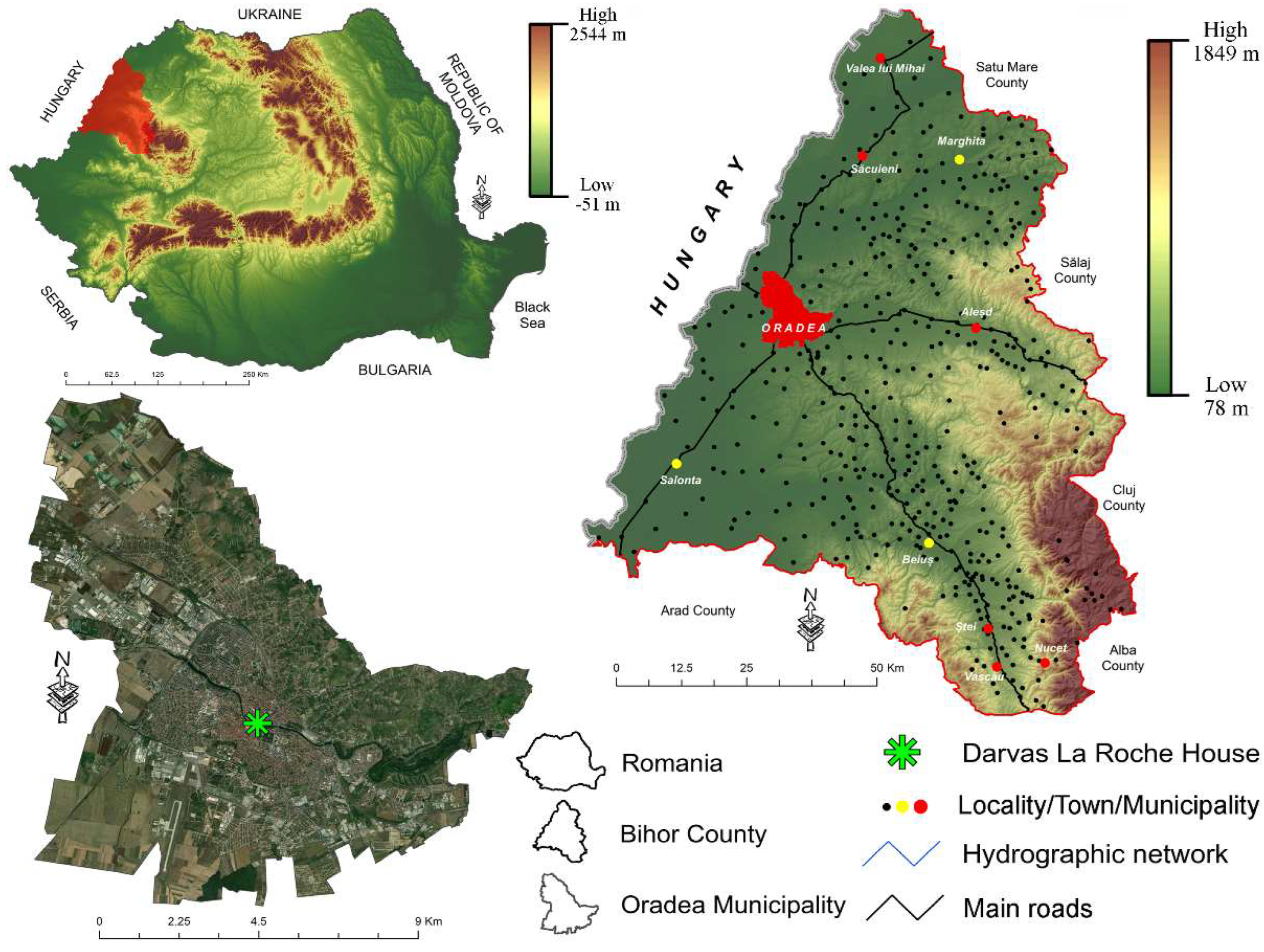

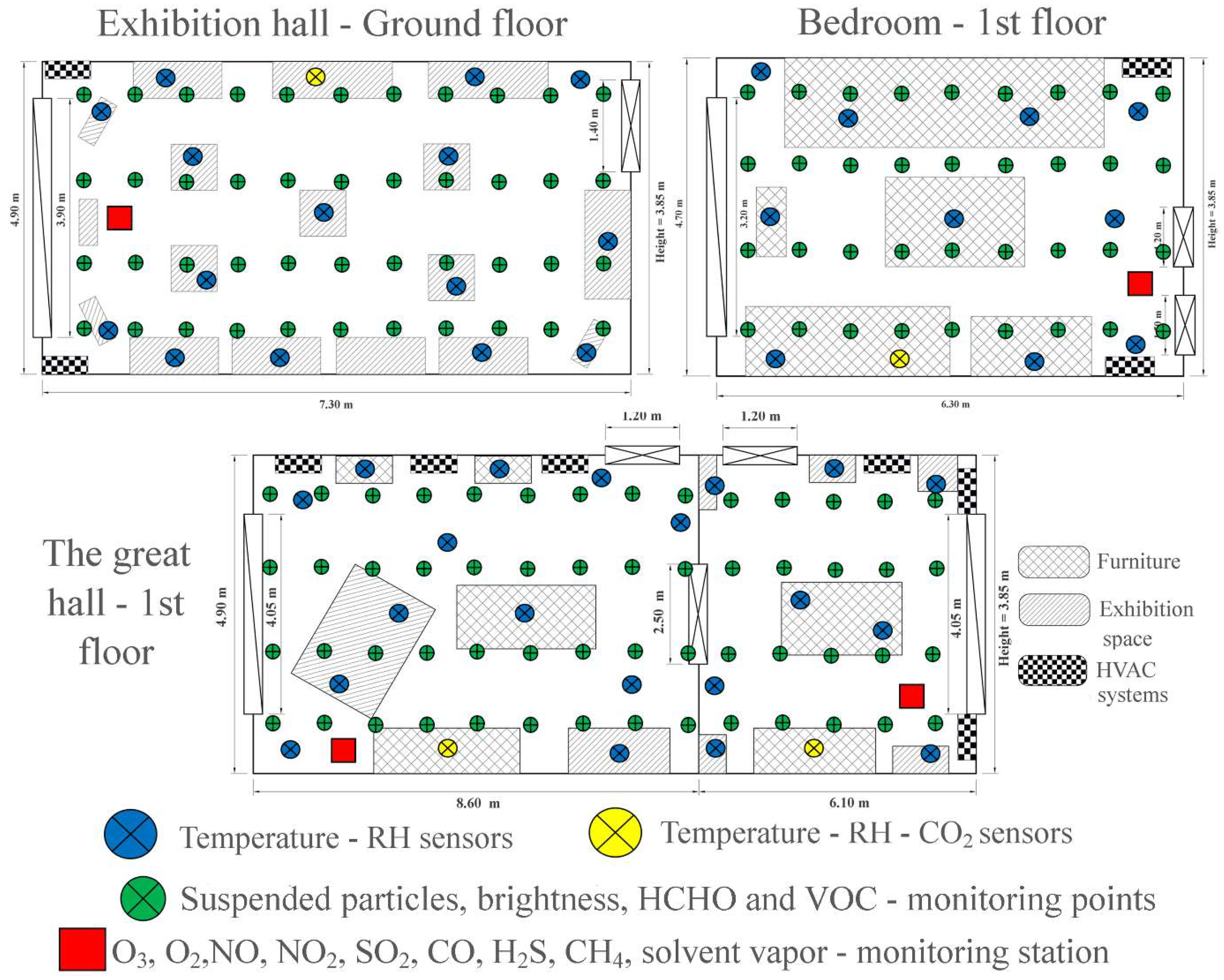
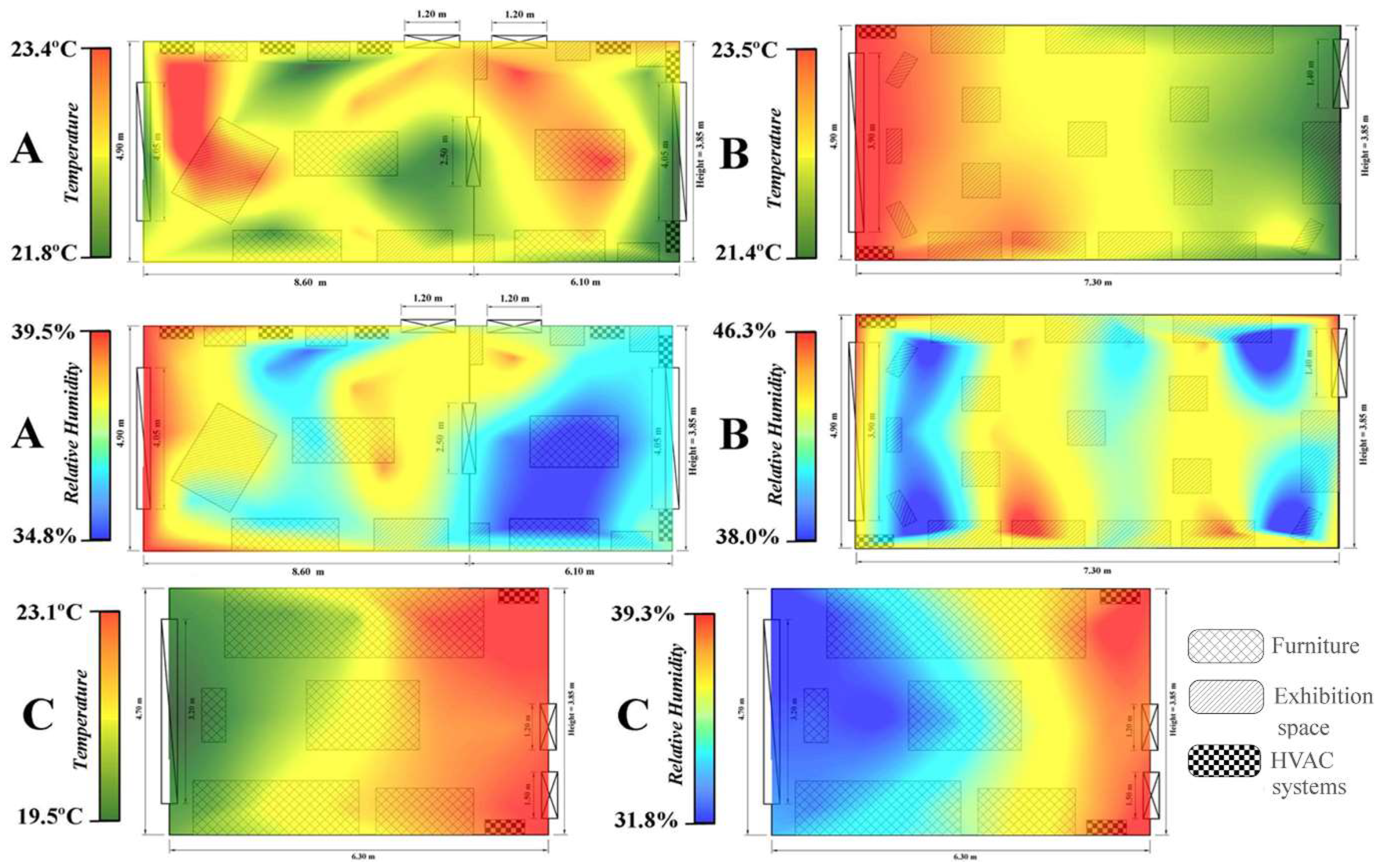


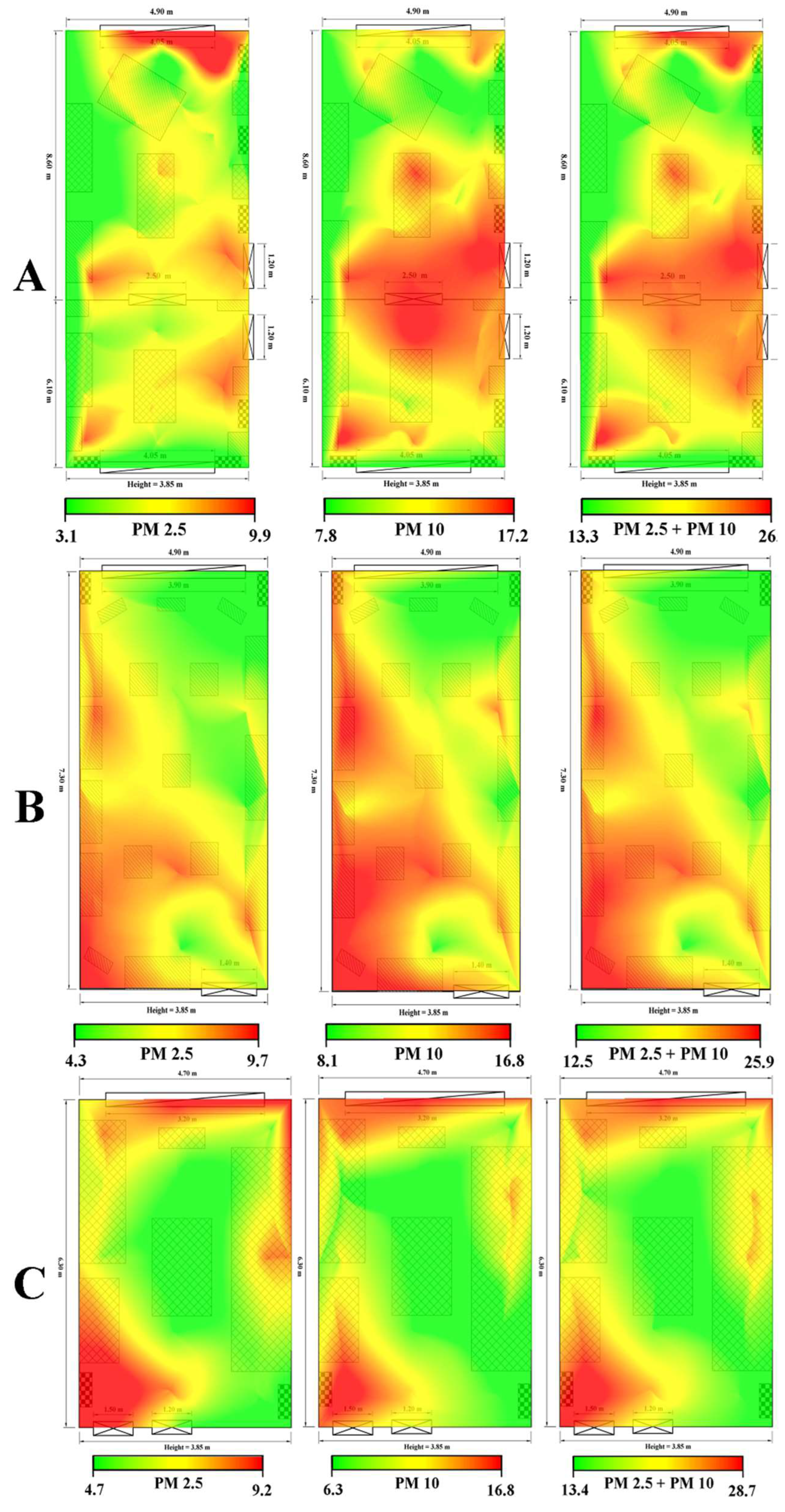
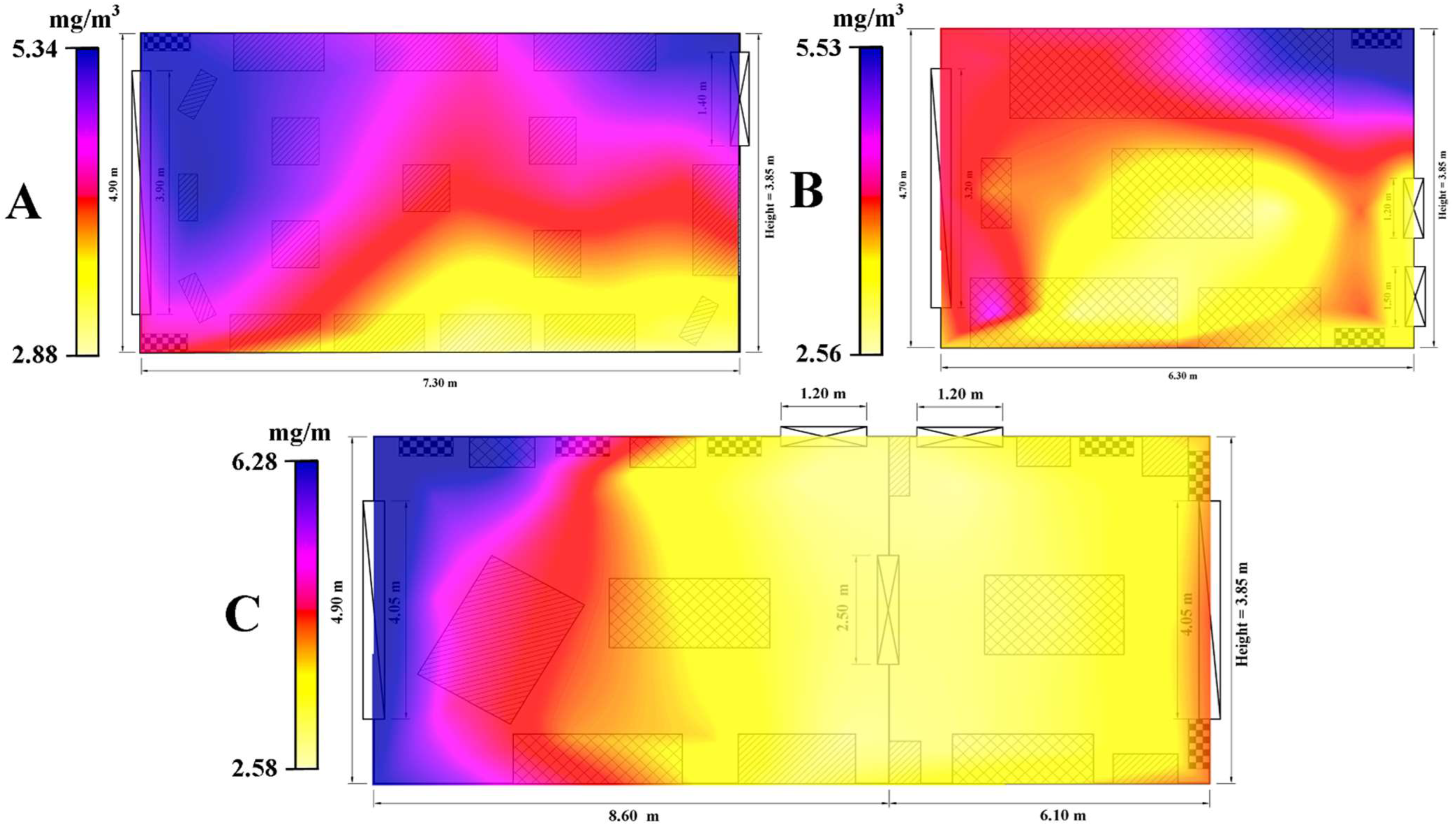
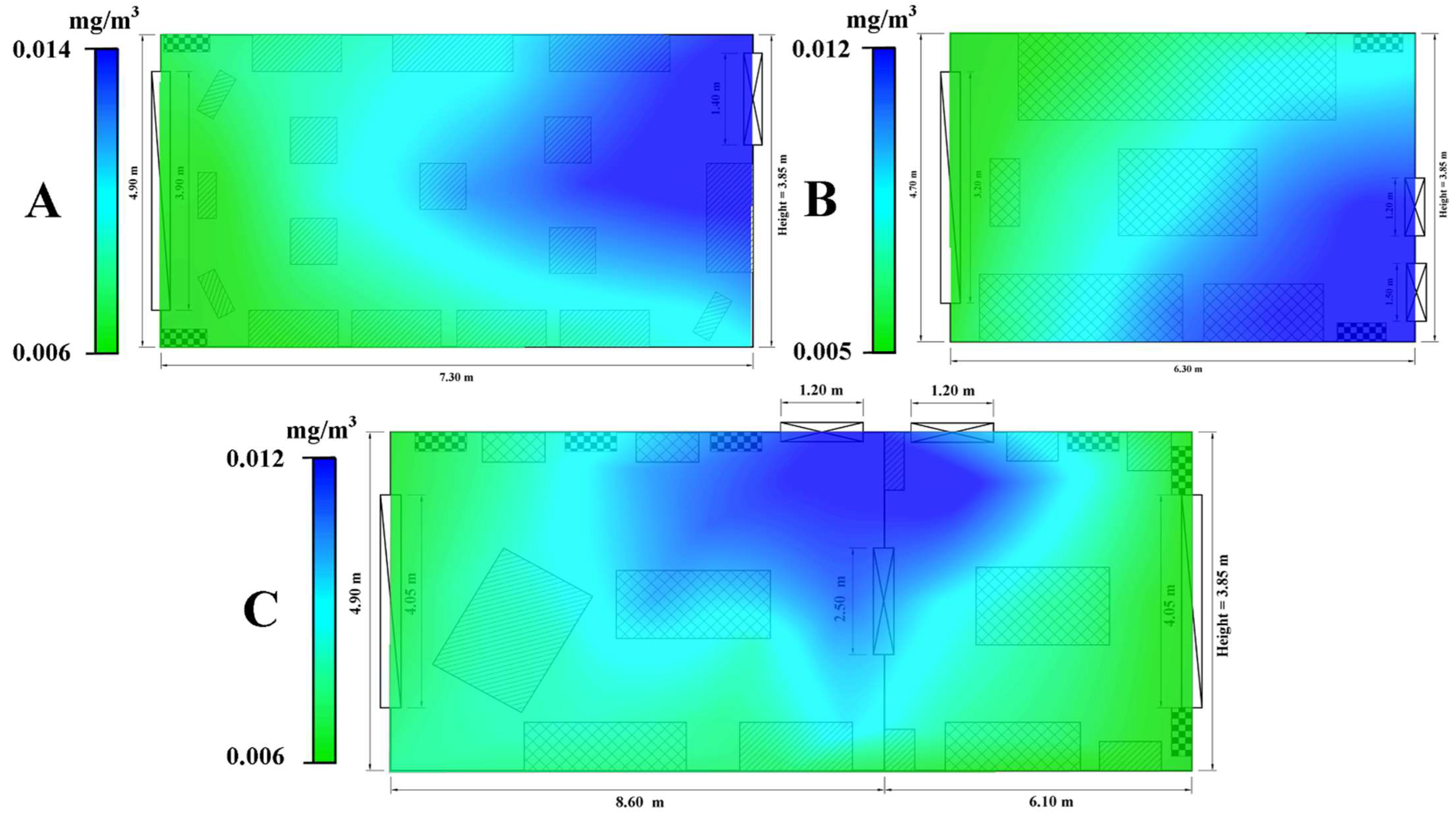


Publisher’s Note: MDPI stays neutral with regard to jurisdictional claims in published maps and institutional affiliations. |
© 2022 by the authors. Licensee MDPI, Basel, Switzerland. This article is an open access article distributed under the terms and conditions of the Creative Commons Attribution (CC BY) license (https://creativecommons.org/licenses/by/4.0/).
Share and Cite
Ilieș, A.; Caciora, T.; Marcu, F.; Berdenov, Z.; Ilieș, G.; Safarov, B.; Hodor, N.; Grama, V.; Shomali, M.A.A.; Ilies, D.C.; et al. Analysis of the Interior Microclimate in Art Nouveau Heritage Buildings for the Protection of Exhibits and Human Health. Int. J. Environ. Res. Public Health 2022, 19, 16599. https://doi.org/10.3390/ijerph192416599
Ilieș A, Caciora T, Marcu F, Berdenov Z, Ilieș G, Safarov B, Hodor N, Grama V, Shomali MAA, Ilies DC, et al. Analysis of the Interior Microclimate in Art Nouveau Heritage Buildings for the Protection of Exhibits and Human Health. International Journal of Environmental Research and Public Health. 2022; 19(24):16599. https://doi.org/10.3390/ijerph192416599
Chicago/Turabian StyleIlieș, Alexandru, Tudor Caciora, Florin Marcu, Zharas Berdenov, Gabriela Ilieș, Bahodirhon Safarov, Nicolaie Hodor, Vasile Grama, Maisa Ali Al Shomali, Dorina Camelia Ilies, and et al. 2022. "Analysis of the Interior Microclimate in Art Nouveau Heritage Buildings for the Protection of Exhibits and Human Health" International Journal of Environmental Research and Public Health 19, no. 24: 16599. https://doi.org/10.3390/ijerph192416599
APA StyleIlieș, A., Caciora, T., Marcu, F., Berdenov, Z., Ilieș, G., Safarov, B., Hodor, N., Grama, V., Shomali, M. A. A., Ilies, D. C., Gaceu, O., Costea, M., & Kieti, D. (2022). Analysis of the Interior Microclimate in Art Nouveau Heritage Buildings for the Protection of Exhibits and Human Health. International Journal of Environmental Research and Public Health, 19(24), 16599. https://doi.org/10.3390/ijerph192416599









